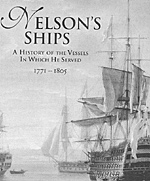Nelson's Ships:
A History of the Vessels
in Which He Served
1771-1805
Book Review
reviewed by Paul Chamberlain, UK
| |
During his career, Nelson served on board 38 ships, of which 36 were naval vessels of varied types and the remaining two were merchantmen. He served in some for long periods, while others saw his presence for only a very brief time. Nelson's Ships is an account of these vessels, including 11 in which he took passage either when ill or when transferring commands. This book has many strands to it. Each vessel is profiled, along with a chronicle of its career. The story of the men who served on board is included, alongside Admiral Nelson's relationship with each vessel and how that ship influenced his career. Using these various features, Peter Goodwin has produced what amounts to an encyclopaedia of ships of the Royal Navy from the late 18th to early 19th Centuries. One example is that of HMS Triumph, a 3rd Rate 74 gun ship launched in 1764. Its design was based upon the French 74 gun L'Invincible that had been captured in 1747. The section on this vessel provides an incredible amount of detail, from the amount of timber used in her construction, to her specifications and service history, whether in ordinary or being prepared for active service in 1771 (for a potential conflict with Spain over the sovereignty of the Falkland Islands). The text details the rigging and ballasting of the vessel, and where this work was performed. In that respect, the book is also an account of the workings of naval dockyards in getting a ship ready for sea. The Triumph was commanded by Captain Maurice Suckling, whose famous nephew joined the ship in May 1771. The section details Nelson's service on board, and the role of the ship in the American War of Independence. During the 1790s the Triumph served at the Battle of Camperdown, and was later in the fleet commanded by Admiral Calder in action against Villeneuve's fleet in July 1805. By 1808 the ship was too old to stand in the line of fire and so was relegated to other tasks. From 1808-09 she was employed escorting convoys of troops and stores to Lisbon in support of the Peninsular Campaign. The author uses ship's logs and Admiralty correspondence to examine the service record of each vessel, and includes charts of refit histories, consumption of stores on board, commanding officers, and the fleets in which the ship served. Nelson's relationship with each vessel is related alongside its general history. This theme is followed with all the vessels, and as the ships on which Nelson served were many and varied, this book covers a broad area of the Royal Navy of the time. Ships described range from the 24 gun frigate Seahorse, the 50 gun Bristol, the Bomb Vessel Carcass, to the 100 gun Victory. Included is the San Josef, one of two Spanish ships captured by Nelson at the Battle of St. Vincent in February 1797 and commissioned into the Royal Navy. There are sections on other ships linked to Nelson such as schooners and merchantmen. Nelson's Ships contains a very detailed examination of a broad selection of vessels used by the Royal Navy, with the link that Nelson served on board all of them in some capacity. The Nelson theme aside, it represents a valuable data source for the Royal Navy of the period. Peter Goodwin has produced a book that is crammed with information, and will be a very useful addition to any library of books on the Royal Navy of the Napoleonic period. Book Reviews Naval Special
Nelson's Ships: A History of the Vessels in Which He Served 1771-1805 The Nelson Encyclopaedia With The Utmost Possible Dispatch: Poems of Nelson's Navy Nelson's Battles Sea Life in Nelson's Time Back to Table of Contents -- First Empire # 74 Back to First Empire List of Issues Back to MagWeb Master Magazine List © Copyright 2004 by First Empire. This article appears in MagWeb.com (Magazine Web) on the Internet World Wide Web. Other articles from military history and related magazines are available at http://www.magweb.com |
 Nelson's Ships: A History of the Vessels in Which He Served 1771-1805
Nelson's Ships: A History of the Vessels in Which He Served 1771-1805